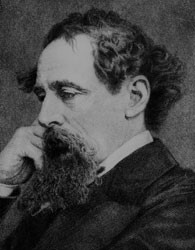Charles Dickens is best remembered for novels such as “Oliver Twist” and “David Copperfield.” For his dedication to social justice, most notably his humanizing portraits of society’s lowest castes, he has been called “the conscience of Victorian England.”
Charles Dickens’ Early Days
Charles Dickens was born on February 7, 1812, into an affluent family in Portea (now called Portsmouth), England. He was the second child of John and Elizabeth Barrow Dickens. His father, a clerk in the Naval Pay Office, was often careless with his money.
Charles lived with his family in Chatham until 1822, when his father was transferred to London. When Charles was 12 years old, his father’s reckless spending landed all of the Dickens family—except Charles and his older sister—in debtor’s prison, according to Fathom. Charles worked at a shoe polish factory and lived at a boarding house; his sister stayed at music school.
The nightmare of being temporarily orphaned, and the cruelty he endured at the factory, was something Dickens shared only with his wife and close confidant, John Forster. It “became a source both of creative energy and of the preoccupation with the themes of alienation and betrayal” that would appear in his later works, according to The Victorian Web.
After his family was released, Dickens attended Wellington House Academy until he was 15. He then began work as a law clerk, learned shorthand and in 1929, left the law offices to pursue a career as a reporter.
Sources in this Story
- Charles Dickens Info: The Childhood of Charles Dickens
- PBS: Oliver Twist: A Dickens Timeline
- The Victorian Web: A Biographical Sketch of Charles Dickens from the 1860 Harper’s Weekly
- David Perdue’s Charles Dickens Page
- The Literature Network: Charles Dickens
- The New York Public Library: Best of Times: The Theatre of Charles Dickens
- BBC: Historic Figures: Charles Dickens (1812–1870)
Charles Dickens’ Notable Accomplishments
While working as a court reporter for the Mirror of Parliament, Dickens began publishing literary sketches and drawings of ordinary London folk under the pseudonym “Boz.” These were later collected and published as two books.
The popularity of his sketches led to a request to write a serial known as “The Pickwick Papers.” Published in 1836, the monthly serial made Dickens famous at only 24 years old, and made serialization “a new Victorian trend,” according to PBS.
In 1836, Dickens married Catherine Hogarth, became editor of the journal Bentley’s Miscellany, and started publishing his first novel, “Oliver Twist,” in serial form. His personal life and career appeared to be flourishing. The following year, however, his wife’s younger sister, whom Dickens adored, suddenly died, deeply upsetting him. That same year, the first of ten children was born to the Dickens family, The Victorian Web reports.
The affordability of the serial and improved literacy made Dickens’ work widely accessible and popular among all classes, according to David Perdue’s Charles Dickens Page. In 1872, a writer for The Daily Telegraph spoke of Dickens’ popularity, saying: [H]is current story was really a topic of the day; it seemed something almost akin to politics and news–as if it belonged not so much to literature but to events,” Fathom noted.
In 1842, after publishing three more novels, Dickens and his wife toured Canada and the United States, where “Boz Ball” was thrown in his honor. One man called it “the greatest affair in modern times,” Fathom reported. The following year, Dickens published “A Christmas Carol.”
In 1849 and 1850, he published “David Copperfield,” his favorite work and also the most autobiographical of his works, according to The Literature Network.
The Rest of the Story
In addition to his novels, Dickens wrote an autobiography and travel books, edited two weekly periodicals and managed two charities, the BBC noted.
In the 1850s, he began writing, directing and acting in plays at Tavistock House. In 1857, he played opposite actress Ellen Ternan, fell in love and left his wife and family the following year, according to The Literature Network. Although his own plays aren’t well known, more people have seen his novels performed than have read them, the New York Public Library explains in its online exhibit, The Theatre of Charles Dickens.
Charles Dickens died on June 9, 1870, following a cerebral hemorrhage, according to The Literature Network reports. He is buried in Poet’s Corner at Westminster Abbey, London. His last book, “The Mystery of Edwin Drood,” was never completed.
“Nearly everyone, whatever his actual conduct may be, responds emotionally to the idea of human brotherhood. Dickens voiced a code which was and on the whole still is believed in, even by people who violate it,” George Orwell wrote, according to The Literature Network.
To find text and HTML editions of Charles Dickens’ books, visit The Literature Page.
Read the last public address given by Charles Dickens at the Royal Academy Dinner in London in 1870.
This article was originally written by Shannon Firth; it was updated December 8, 2016.











